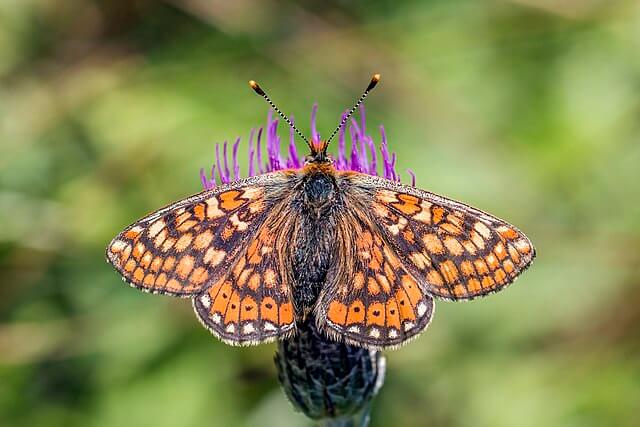
The endangered marsh fritillary butterfly has made a remarkable comeback in a Lake District valley, thanks to a change in grazing habits.
Previously extinct in Cumbria for 19 years, the butterfly is now spreading across the landscape due to an official reintroduction program.
This summer, the marsh fritillary has been spotted in the Swindale valley, which is part of the Royal Society for the Protection of Birds (RSPB) Haweswater area. Conservationists had considered reintroducing the species here but found that they didn’t need to intervene directly, as radical grazing changes have naturally allowed the butterfly to flourish. The RSPB manages the 3,000-hectare site in partnership with landowner United Utilities.
Previously, the area was home to 1,600 breeding ewes, but since the RSPB took over, the number has been reduced to 280. These sheep now undergo rotational grazing on lowland farmland, which has allowed an abundance of wildflowers and plants to thrive.
The revival of the marsh fritillary in Swindale is largely attributed to a significant increase in its food plant, the devil’s-bit scabious. The valley’s meadows were previously dominated by coarse grasses that sheep refused to eat.
“The next spring, it was absolutely carpeted in heath spotted orchids and later in the summer masses of devil’s-bit scabious,” said Lee Schofield, a senior site manager for the RSPB at Haweswater.
“These flowers have spread and spread over the last few years. The fell ponies are the key to this success – if we hadn’t changed the grazing and used these big native herbivores we wouldn’t have the scabious and we wouldn’t have the butterfly.”
However, with the introduction of native fell ponies, who graze the area in late autumn, the coarse grasses were devoured. Additionally, Highland and belted Galloway cattle have been brought back to graze lightly, while a more natural hydrology has been restored, providing more damp ground where the flowers can flourish.
“I’ve never seen so much devil’s-bit scabious and I’d be surprised if we don’t see the marsh fritillary popping up throughout Swindale valley,” said Schofield, whose book, Wild Fell, documents the transformation of the Lakeland reserve and the wider landscape.
These grazing changes have also benefited other insects, including grasshoppers, grass-feeding moth species, and other butterflies like the dark green fritillary and the small pearl-bordered fritillary.
The marsh fritillary has faced some controversy in its reintroduction to various isolated sites across Britain by independent breeders. Nonetheless, the reappearance of the butterfly in a few locations in Cumbria seems to be a natural spread from neighboring valleys, where it reappeared last year.
The butterfly’s revival in Cumbria is a testament to the success of the original reintroduction program overseen by Butterfly Conservation. The caterpillars form distinctive and numerous larval webs, but by 2004, there was only one batch of caterpillars at one site in Cumbria. To enhance the species’ genetic vigor, caterpillars were collected from southern Scotland, and nearly 50,000 captive-bred caterpillars were returned to four sites in 2007.
Over time, the butterfly has expanded to suitably restored wet meadows in the region, creating a more resilient “meta-population” that prevents isolation and genetic restrictions.
In further support of the butterfly’s prospects, the Cumbria Connect project aims to restore nature-friendly farming across 33,000 hectares, an area larger than Birmingham. Funded by the Endangered Landscapes Programme, the project collaborates with farmers interested in changing their land management practices to restore more natural rivers and diverse grazing, benefiting various declining plant and animal species.
“We absolutely recognise the value of grazing and if we stopped I don’t think the marsh fritillary would last very long,” said Schofield.
——————————————————————————
At Natural World Fund, we are passionate about stopping the decline in our wildlife.
The declines in our wildlife is shocking and frightening. Without much more support, many of the animals we know and love will continue in their declines towards extinction.
When you help to restore a patch of degraded land through rewilding to forests, meadows, or wetlands, you have a massive impact on the biodiversity at a local level. You give animals a home and food that they otherwise would not have had, and it has a positive snowball effect for the food chain.
We are convinced that this is much better for the UK than growing lots of fast-growing coniferous trees, solely to remove carbon, that don’t actually help our animals to thrive.
This is why we stand for restoring nature in the UK through responsible rewilding. For us, it is the right thing to do. Let’s do what’s right for nature!
Donate today at https://naturalworldfund.com/ and join in the solution!

